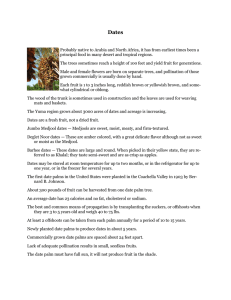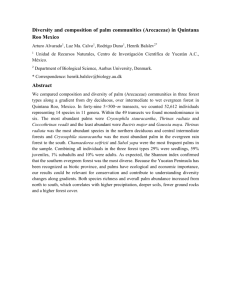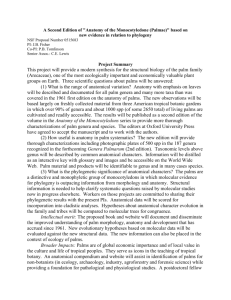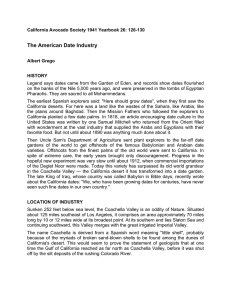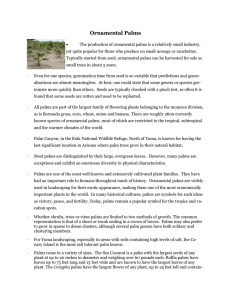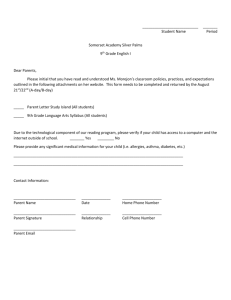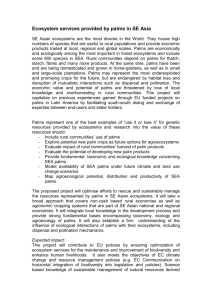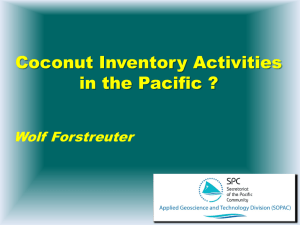Date Palm DOCX - Northern Territory Government
advertisement
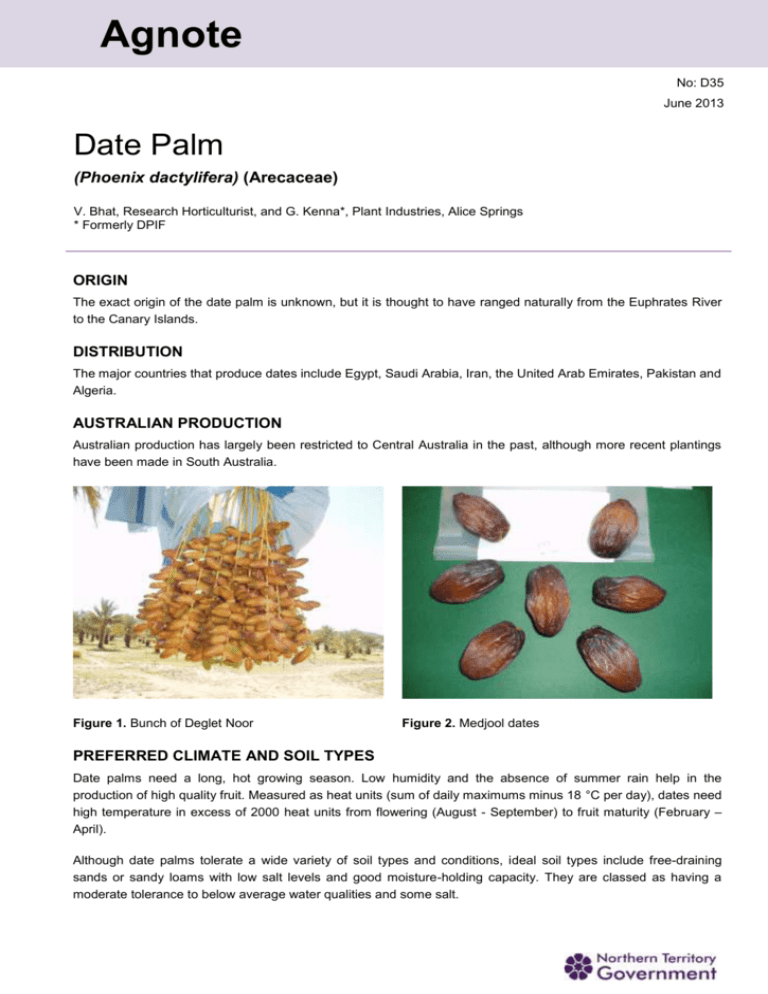
Agnote No: D35 June 2013 Date Palm (Phoenix dactylifera) (Arecaceae) V. Bhat, Research Horticulturist, and G. Kenna*, Plant Industries, Alice Springs * Formerly DPIF ORIGIN The exact origin of the date palm is unknown, but it is thought to have ranged naturally from the Euphrates River to the Canary Islands. DISTRIBUTION The major countries that produce dates include Egypt, Saudi Arabia, Iran, the United Arab Emirates, Pakistan and Algeria. AUSTRALIAN PRODUCTION Australian production has largely been restricted to Central Australia in the past, although more recent plantings have been made in South Australia. Figure 1. Bunch of Deglet Noor Figure 2. Medjool dates PREFERRED CLIMATE AND SOIL TYPES Date palms need a long, hot growing season. Low humidity and the absence of summer rain help in the production of high quality fruit. Measured as heat units (sum of daily maximums minus 18 °C per day), dates need high temperature in excess of 2000 heat units from flowering (August - September) to fruit maturity (February – April). Although date palms tolerate a wide variety of soil types and conditions, ideal soil types include free-draining sands or sandy loams with low salt levels and good moisture-holding capacity. They are classed as having a moderate tolerance to below average water qualities and some salt. Dates are relatively thirsty for water, requiring up to 27 ML/ha (with 123 palms/ha) for mature palms at ten years of age. DESCRIPTION The date palm belongs to the Arecaceae family and to the same genus as other ornamental palms, such as the Canary Island palm (P. canariensis) and the sugar palm (P. sylvestris). The date palm is a dioecious (separate male and female) plant that grows to around 20 m in height and may live for 100 years. Up to 25 leaves, or fronds, can be produced every four years, and each may be functional for up to four years. Flowers emerge in spathes from the single growing apex and are multi-stemmed. VARIETIES Numerous varieties are available for commercial production. The most commonly grown are Medjool, Barhee and Deglet Noor. CULTURE Most commonly, date palms are propagated from their offshoots that sprout from the base of the parent palm. Palms usually begin to produce offshoots in their second year and continue to do so until the age of 12. Offshoots can be removed and used as planting material once they have reached 15 cm in diameter. Whether the offshoots are to be used for propagation or not, they should still be removed or trimmed off the palm as they compete for nutrients and influence the growth and development of the parent palm. Tissue culture may also be used as a propagation technique, and is a preferred method for importing plant material that conforms to quarantine regulations. Planting of seedlings is discouraged as they can result in either male or female plants (no certainty) with a wide variation in growth and fruit qualities. PESTS AND DISEASES Date palms grown in hot dry areas such as Alice Springs, are largely free of pests and diseases. Parlatoria scale is a major insect pest in many parts of Australia and can attack date palms reducing vigour and yield, and may result in a downgrading of fruit quality. Timely pruning and trimming of the palms coupled with two annual rounds of insecticidal spray significantly improves control of the pest. Figure 3. Spraying pesticide for scale management Figure 4. Palms being supported by ‘earthing up’ © Northern Territory Government Page 2 of 3 FRUITING SEASON In Central Australia, flowering takes place around August to October with fruit maturing between February and April for harvesting, depending on the variety and the stage of maturity. The green developing fruits (kimri, stage 1) change their colour to yellow/orange/purple (khalal, stage 2) before turning softer and faded/darker in their colour shades (rutab, stage 3) and then hardened and dried dates (tamar, stage 4). Barhee dates are fit for harvesting (as whole bunch) during the second and third stages while, Medjool dates need to be picked as individual soft dates in the third stage. Deglet Noor dates are ready for harvest in the third and fourth stages (whole bunch). HARVESTING Commercial date production is highly labour-intensive. Hand pollination of female flowers (from pollen collected from male palms) is required to produce commercial yields. Fruit thinning, fitting covers to protect from birds, tying bunches to fronds, and a long harvest season all increase labour input. However, access to fresh fruit and good economic returns, plus the suitability of date palms to saline land and water, and the resilience and longevity of the date palm make its cultivation attractive. Figure 5. Bagging fruit (‘bunch covering’) Figure 6. Processing pollen STORAGE CONDITIONS Fresh dates store well when refrigerated and may be frozen. Dried dates have an extended shelf-life without refrigeration and are often found in dried-fruit sections of markets or are pre-packaged. CULINARY USE Most dates are consumed fresh or dried, depending on the variety. Dates are often used for cooking (breads, cakes or puddings) and can be used in jams or chutneys. Please visit us at our website: www.nt.gov.au/d © Northern Territory Government ISSN 0157-8243 Serial No. 686 Agdex No. 232/11 Disclaimer: While all care has been taken to ensure that information contained in this document is true and correct at the time of publication, the Northern Territory of Australia gives no warranty or assurance, and makes no representation as to the accuracy of any information or advice contained in this publication, or that it is suitable for your intended use. No serious, business or investment decisions should be made in reliance on this information without obtaining independent and/or professional advice in relation to your particular situation. © Northern Territory Government Page 3 of 3

